

Technical Files Homepage
RGM-79 GM Standard Production Mobile Suit (RGM-79A, -79C, -79D, -79G, -79K, -79N, -79FA-01, -79S)

I. Dimensions:
| RGM-79A | RGM-79C | RGM-79D | RGM-79G | RGM-79K | RGM-79N | RGM-79FA | RGM-79S | |
| Total Height: | 18.5 meters | 18.5 meters | 18.5 meters | 18.0 meters | 18.4 meters | 19.0 meters | 20.0 meters | 18.5 meters |
| Total Depth: | 3.8 meters | 4.5 meters | 3.8 meters | 4.0 meters | 3.8 meters | 4.1 meters | 5.5 meters | 3.5 meters |
| Total Breadth: | 7.6 meters | 7.2 meters | 7.6 meters | 7.3 meters | 7.6 meters | 8.0 meters | 8.5 meters | 6.2 meters |
| Dry Weight: | 20.6 metric tons | 20.6 metric tons | 20.2 metric tons | 22.3 metric tons | 25.0 metric tons | 21.0 metric tons | 23.7 metric tons | 22.5 metric tons |
| Operational Weight: | 38.2 metric tons | 38.2 metric tons | 38.2 metric tons | 39.9 metric tons | 46.6 metric tons | 38.6 metric tons | 58.6 metric tons | 41.6 metric tons |
II. Type
III. Service Use
IV. Propulsion
Engines:
(RGM-79A, -79D)
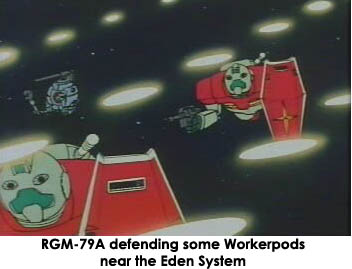 2 x Icarus Aerospace AST-16 thrusters on the back, total thrust 212 kN
each.
2 x Icarus Aerospace AST-16 thrusters on the back, total thrust 212 kN
each.(RGM-79C)
(RGM-79G)
(RGM-79K)
(RGM-79N, -79FA-01)
(RGM-79S)
Powerplant:
(RGM-79A, -79C, -79D, -79G, -79K)
(RGM-79N, -79FA, -79S)
Fuel Capacity:
(RGM-79A, -79C, -79D, -79G, -79K)
2O reactant for fusion engines.(RGM-79N, -79FA-01)
2O reactant for fusion engines.(RGM-79S)
2O reactant for fusion engines.V. Performance
| RGM-79A | RGM-79C | RGM-79D | RGM-79G | RGM-79K | RGM-79N | RGM-79FA | RGM-79S | |
| Running speed: | 102 kph | 110 kph | 105 kph | 120 kph | 83 kph | 186 kph | 84 kph | 191 kph |
| Max loiter time: | 45 seconds | 45 seconds | 45 seconds | 45 seconds | 45 seconds | 75 seconds | 30 seconds | 75 seconds |
| Jump distance:(*) | 100 meters | 150 meters | 100 meters | 150 meters | 75 meters | 200 meters | 50 meters | 250 meters |
| Cell duration:(**) | 100 hours | 100 hours | 120 hours | 100 hours | 100 hours | 100 hours | 100 hours | 100 hours |
| Acceleration: | 1.1 G | 1.3 G | 1.1 G | 1.7 G | 0.9 G | 1.6 G | 1.0 G | 2.2 G |
| Delta-v capacity: | 51.6 kps | 63.5 kps | 53.3 kps | 72.8 kps | 52.2 kps | 88.9 kps | 61.6 kps | 115.7 kps |
| * = Earth-normal conditions and without thrusters | ||||||||
| ** = Continuous operational use. |
VI. Electronics
Radar tracking:
(RGM-79A, -79C, -79D, -79G, -79N)
(RGM-79K, -79FA)
(RGM-79S)
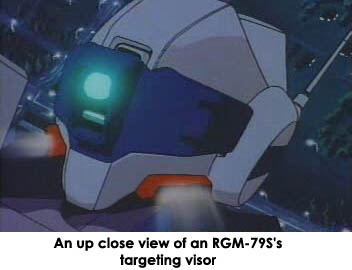 General Electric AN/APG-161 X-Band, pulse
Doppler, providing long range
detection and tracking of targets at all altitudes.
General Electric AN/APG-161 X-Band, pulse
Doppler, providing long range
detection and tracking of targets at all altitudes.Optical tracking:
(RGM-79A, -79C, -79D, -79G, -79N, -79FA)
(RGM-79K)
(RGM-79S)
Tactical Electronic Warfare System (TEWS):
 Loral AN/ALR-26 radar warning receiver (RWR)
Loral AN/ALR-26 radar warning receiver (RWR)(RGM-79S after 2058)
(RGM-79D)
VII. Armament
Cannon
(RGM-79A,- 79C, -79G, -79K ,-79N, -79FA)
(RGM-79K)
(RGM-79FA)
Hand Held Weapon
 1
x Three Star GU-24 100mm assault rifle: The main
weapon of the RGM-79 series is the GU-24 assault rifle produced by Three
Star. Resembling a traditional veritech gun pod, the GU-24 is a single
barrel weapon with a much larger barrel. This is an ideal arrangement
for the mobile suits used to defeat heavily armored foes. The GU-24
uses a magazines each containing 20 rounds of ammunition. The
ammunition is a mix of
Tungsten-coated depleted Uranium Armor Piercing Spin-Stabilized Discarding
Sabot (APSSDS), High Explosive Armor Piercing (HEAP) and tracer rounds.
The rifle is capable of firing in multiple modes, single shot, semi-automatic (5
round burst), or full automatic at 150 rounds per minute. The GU-24
comes with a collapsible stock and swing out handle for improved
accuracy. Two spare
magazines for the GU-24 can be found behind the GM's armored shield.
1
x Three Star GU-24 100mm assault rifle: The main
weapon of the RGM-79 series is the GU-24 assault rifle produced by Three
Star. Resembling a traditional veritech gun pod, the GU-24 is a single
barrel weapon with a much larger barrel. This is an ideal arrangement
for the mobile suits used to defeat heavily armored foes. The GU-24
uses a magazines each containing 20 rounds of ammunition. The
ammunition is a mix of
Tungsten-coated depleted Uranium Armor Piercing Spin-Stabilized Discarding
Sabot (APSSDS), High Explosive Armor Piercing (HEAP) and tracer rounds.
The rifle is capable of firing in multiple modes, single shot, semi-automatic (5
round burst), or full automatic at 150 rounds per minute. The GU-24
comes with a collapsible stock and swing out handle for improved
accuracy. Two spare
magazines for the GU-24 can be found behind the GM's armored shield.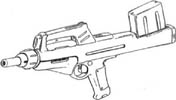 or
1 x Hughes GU-25 90mm assault rifle: As
an alternate weapon to the 100mm assault rifle, the GM can utilize the GU-25
which provides a higher
firing rate of 220 rounds per minute. The GU-25 is designed for
situations where volume of fire matters more than damage of fire. The
GU-25 uses magazines containing 30 rounds of ammunition. Ammunition is the standard mix of
Tungsten-coated depleted Uranium Armor Piercing Spin-Stabilized Discarding
Sabot (APSSDS), High Explosive Armor Piercing (HEAP) and tracer rounds.
The rifle is capable of firing in multiple modes, single shot, semi-automatic (5
round burst), or full automatic at 220 rounds per minute. The
GU-25 uses a bullpup design to reduce size and recoil of the weapon making
the GU-25 ideal for urban combat situations. Two spare magazines can
be stored behind the GM's armored shield.
or
1 x Hughes GU-25 90mm assault rifle: As
an alternate weapon to the 100mm assault rifle, the GM can utilize the GU-25
which provides a higher
firing rate of 220 rounds per minute. The GU-25 is designed for
situations where volume of fire matters more than damage of fire. The
GU-25 uses magazines containing 30 rounds of ammunition. Ammunition is the standard mix of
Tungsten-coated depleted Uranium Armor Piercing Spin-Stabilized Discarding
Sabot (APSSDS), High Explosive Armor Piercing (HEAP) and tracer rounds.
The rifle is capable of firing in multiple modes, single shot, semi-automatic (5
round burst), or full automatic at 220 rounds per minute. The
GU-25 uses a bullpup design to reduce size and recoil of the weapon making
the GU-25 ideal for urban combat situations. Two spare magazines can
be stored behind the GM's armored shield.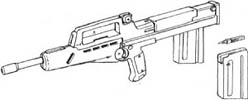 or
(after 2052) 1 x Hughes GU-26 90mm assault rifle: A
successor to the GU-25, the GU-26 holds more ammo and was designed for use
with the RGM-79N and Full Armor variants. The assault rifle also drops
the fully automatic ability. Ammunition capacity is now increased from
30 rounds as seen in the GU-25 to 40 rounds. Ammunition is a mix of
Tungsten-coated depleted Uranium Armor Piercing Spin-Stabilized Discarding
Sabot (APSSDS), High Explosive Armor Piercing (HEAP) and tracer rounds.
The rifle is capable of firing in multiple modes, single shot or semi-auto (5
round burst). Two spare
magazines for the GU-26 can be found mounted one each on the hip armor on
some models, while others store them behind the RGM-79's massive projectile
shield.
or
(after 2052) 1 x Hughes GU-26 90mm assault rifle: A
successor to the GU-25, the GU-26 holds more ammo and was designed for use
with the RGM-79N and Full Armor variants. The assault rifle also drops
the fully automatic ability. Ammunition capacity is now increased from
30 rounds as seen in the GU-25 to 40 rounds. Ammunition is a mix of
Tungsten-coated depleted Uranium Armor Piercing Spin-Stabilized Discarding
Sabot (APSSDS), High Explosive Armor Piercing (HEAP) and tracer rounds.
The rifle is capable of firing in multiple modes, single shot or semi-auto (5
round burst). Two spare
magazines for the GU-26 can be found mounted one each on the hip armor on
some models, while others store them behind the RGM-79's massive projectile
shield.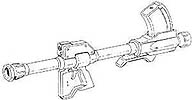 or
1 x Three Star RU-33 260mm missile launcher: This rather large
weapon is the heavy multi-purpose assault weapon of the RGM-79.
Carrying a specialized version of the MPM-10,
the MPM-10C
Dirk short range mini-missile. This unique version of the MPM-10
Dirk carries a warhead twice the size of the standard MPM-10
warhead. Of course this comes at the price of guidance and
range. When not in
use this weapon can be placed on a special mount on the back of the unit
freeing the hands for other uses such as wielding the beam saber or a
projectile shield. The missile launcher utilizes external magazines of
ammunition each holding 5 missiles. Two spare magazines can usually be
found behind the projectile shield. The missile launcher can only use the MPM-10C
Dirk.
or
1 x Three Star RU-33 260mm missile launcher: This rather large
weapon is the heavy multi-purpose assault weapon of the RGM-79.
Carrying a specialized version of the MPM-10,
the MPM-10C
Dirk short range mini-missile. This unique version of the MPM-10
Dirk carries a warhead twice the size of the standard MPM-10
warhead. Of course this comes at the price of guidance and
range. When not in
use this weapon can be placed on a special mount on the back of the unit
freeing the hands for other uses such as wielding the beam saber or a
projectile shield. The missile launcher utilizes external magazines of
ammunition each holding 5 missiles. Two spare magazines can usually be
found behind the projectile shield. The missile launcher can only use the MPM-10C
Dirk.  or
1 x Three Star RU-35 360mm missile launcher: When conducting
heavy assault hit and run raids the GM uses this derivative of the launcher
used on the Gundam. The launcher uses the
same MPM-10D
as the RU-30 launcher. When not in
use this weapon can be placed on a special mount on the back of the unit
freeing the hands for other uses such as wielding the beam saber or a
projectile shield. Like the RU-30 though, the RU-35 cannot be reloaded
in the field as it uses an internal magazine of 5 missiles with one in the
chamber.
or
1 x Three Star RU-35 360mm missile launcher: When conducting
heavy assault hit and run raids the GM uses this derivative of the launcher
used on the Gundam. The launcher uses the
same MPM-10D
as the RU-30 launcher. When not in
use this weapon can be placed on a special mount on the back of the unit
freeing the hands for other uses such as wielding the beam saber or a
projectile shield. Like the RU-30 though, the RU-35 cannot be reloaded
in the field as it uses an internal magazine of 5 missiles with one in the
chamber. or 1 x Raytheon 6-tube missile launcher: The ability to carry surgical strikes is important to the RGM-79 and to complete this task it has a six tube medium range missile launcher. This launcher built by Raytheon can hold up to twelve medium range missiles of any kind, though usually the MPM-15 Rapier is used. The missile launcher has six missiles ready to fire with one set of reloads.
 or
1 x Three Star 180mm electromagnetic rail cannon: When the GM
needs long range firepower against a variety of targets, the choice is the
180mm rail cannon. This cannon, while not as powerful as the cannon on
the RGM-79K, it still packs quite a punch and is very versatile earning it
the moniker '180mm anti-everything cannon'. The cannon fires a 450 kg
shell distances of up to 50 km with excellent accuracy thanks to self guided
shells. The available ammunition consists of KCP Kinetic Core Penetrating
(hull penetration rounds), KPI Kinetic Penetrating Incendiary (plasma
incendiary rounds) and MKEP Multiple Kinetic Energy Penetrator (flechette
cluster rounds), the latter as anti-mecha formation weapons. The
cannon carries five shells internally in a large magazine. One spare magazine
is usually mounted under the projectile shield, however reloading this large
and cumbersome weapon takes several times as long as reloading any other
type of weapon, usually around thirty seconds.
or
1 x Three Star 180mm electromagnetic rail cannon: When the GM
needs long range firepower against a variety of targets, the choice is the
180mm rail cannon. This cannon, while not as powerful as the cannon on
the RGM-79K, it still packs quite a punch and is very versatile earning it
the moniker '180mm anti-everything cannon'. The cannon fires a 450 kg
shell distances of up to 50 km with excellent accuracy thanks to self guided
shells. The available ammunition consists of KCP Kinetic Core Penetrating
(hull penetration rounds), KPI Kinetic Penetrating Incendiary (plasma
incendiary rounds) and MKEP Multiple Kinetic Energy Penetrator (flechette
cluster rounds), the latter as anti-mecha formation weapons. The
cannon carries five shells internally in a large magazine. One spare magazine
is usually mounted under the projectile shield, however reloading this large
and cumbersome weapon takes several times as long as reloading any other
type of weapon, usually around thirty seconds.
 or
(RGM-79S only) 1 x Rheinmetall BR-06 single-barreled tachyon
rifle: Designed as an alternate method to carry
out surgical strikes when anti-aircraft fire is to intense for missiles, the
BR-06 long range beam rifle can strike targets up to 75km distant with
relative ease. Being only used by the RGM-79S, this weapon can fire a
500 MJ pulse with devastating accuracy. The major drawback to the
weapon is its refire rate and payload. The rifle can only fire one
shot every fifteen seconds and only carries enough energy for six
shots. However as it was designed as a sniper weapon, these are
relatively small problems.
or
(RGM-79S only) 1 x Rheinmetall BR-06 single-barreled tachyon
rifle: Designed as an alternate method to carry
out surgical strikes when anti-aircraft fire is to intense for missiles, the
BR-06 long range beam rifle can strike targets up to 75km distant with
relative ease. Being only used by the RGM-79S, this weapon can fire a
500 MJ pulse with devastating accuracy. The major drawback to the
weapon is its refire rate and payload. The rifle can only fire one
shot every fifteen seconds and only carries enough energy for six
shots. However as it was designed as a sniper weapon, these are
relatively small problems.Melee Weapon
 1
x Shinara 0.38 MW tachyon beam saber: These revolutionary
mecha-sized melee weapon were first used on the Gundam mobile suit. The beam
saber only contains enough energy and particles for about 60 seconds of
continuous use. When not in use, the beam sabers are stored in the backpack
of the mecha, where they are recharged by the GM's reactor. The GM can
switch the beam saber on and off while holding it, in order to conserve
power. Once totally depleted it takes 30 minutes for a beam saber to
recharge to full capacity. The GM carries one beam saber mounted on its
backpack.
1
x Shinara 0.38 MW tachyon beam saber: These revolutionary
mecha-sized melee weapon were first used on the Gundam mobile suit. The beam
saber only contains enough energy and particles for about 60 seconds of
continuous use. When not in use, the beam sabers are stored in the backpack
of the mecha, where they are recharged by the GM's reactor. The GM can
switch the beam saber on and off while holding it, in order to conserve
power. Once totally depleted it takes 30 minutes for a beam saber to
recharge to full capacity. The GM carries one beam saber mounted on its
backpack.Missiles
Other Military Cargoes available include:
VIII. Armor
The armor on the RGM-79 is a low-mass lunarium tungsten composite plating that is the standard for most Terran mecha. Aside from the good protection provided against projectiles, missiles, and other kinetic weapons, this armor is also resistant to plasma globes (annihilation discs), lasers, and fair against, particle guns too, owing to the fact that the armor can flake off and evaporate in layers under fire from such high-energy weapons, taking much of the weapon's energy and converting it into the latent heat of sublimation in the armor. The armor stops all small arms fire, and has good resistance to all weapons commonly mounted on combat mecha.
The GM provides full protection from nuclear, biological, and chemical hazards, using an overpressure cockpit environment activated by radiation and hazardous chemical sensors, or manually when biological warfare conditions are anticipated. The internal consumables supplies can provide atmosphere for three days maximum.
IX. Development
During the initial development of the mobile suit that became known as the Gundam, it became clear to Anaheim Electronics that it would be far too expensive to produce on a large scale. To counter this, they developed a versatile design that was both cheap, easy to pilot, and produce. The design became known as the RGM-79 GM. The GM differed in many ways from its more expensive brother. The GM used much more conventional armor rather than the new and very expensive Gundarium. The GM also lacked the tachyon rifle which was also very expensive. The only other major change was to use slightly less powerful engines to further reduce costs.
For weaponry the basic GM can use one of several types of weapons which vary from mission to mission. The basic default weapon for the RGM-79 series is the GU-24 100mm assault rifle. This rifle, patterned after the gunpods used by the veritech fighters, provides an excellent amount of firepower and exceptional accuracy. In addition to the assault rifle, the GM can also use a smaller assault rifle which delivers at a higher rate of fire, this is often used in situations when accuracy is not essential, and merely laying down fire is a must. For heavy assault work, the GM has several options. There is the RU-33 and RU-35 missile launchers which fires modified versions of the MPM-10 designed to be able to punch through most armor and severely damage most mecha with only one shot. The GM can also be outfitted with a six tube missile launcher which carries twelve MPM-15 Rapier medium range missiles. The final weapon for the GM series is the 180mm "anti-everything" rail cannon. This massive cannon can be fired at extremely long ranges and can punch serious holes into anything it hits. Different ammo types can be used of course which change based on mission profile. The GM series also have one beam saber in addition to the standard head mounted 60mm autocannons.
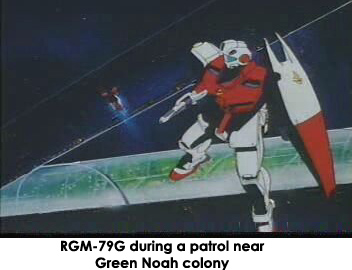 First
deployed alongside the RGM-78 Gundam, the RGM-79A GM was quickly replaced by the
RGM-79C GM Modified which added an additional pair of thrusters on he back which
added to combat endurance if one engine was destroyed or failed for some
reason. The GM Modified also had far superior performance to the -79A.
At the same time as the -79C, the -79G also entered service as the mobile suit
for the higher ranking members within a platoon. The -79G had improved
electronics and engines, but no additional armor or weapons. The final
mobile suit to be released that year was the RGM-79D, a two-seat trainer
variant of the standard RGM-79A. With the trainee pilot sitting in the standard
cockpit, the instructor pilot sat in another seat above his, equipped with a
small window. The GM Trainer mimicked the standard GM in almost every respect,
although it was built with weaker armor to reduce its cost.
First
deployed alongside the RGM-78 Gundam, the RGM-79A GM was quickly replaced by the
RGM-79C GM Modified which added an additional pair of thrusters on he back which
added to combat endurance if one engine was destroyed or failed for some
reason. The GM Modified also had far superior performance to the -79A.
At the same time as the -79C, the -79G also entered service as the mobile suit
for the higher ranking members within a platoon. The -79G had improved
electronics and engines, but no additional armor or weapons. The final
mobile suit to be released that year was the RGM-79D, a two-seat trainer
variant of the standard RGM-79A. With the trainee pilot sitting in the standard
cockpit, the instructor pilot sat in another seat above his, equipped with a
small window. The GM Trainer mimicked the standard GM in almost every respect,
although it was built with weaker armor to reduce its cost.
The following year, another version hit the battlefield, the RGM-79K. The -79K was modeled after the -79A and featured very capable sensors with longer ranges than the standard sensor suite. The biggest addition to the suit however was the 240mm shoulder mounted rail cannon. This made the suit a walking artillery piece capable of severely damaging many mecha with a single shot. This firepower did come at a price, agility. The -79K is far less agile and quick when compared to other mobile suits, but still has enough to make it a viable unit though. Many platoons received two though some received as many eight making them long range attack platoons.
2052 saw the introduction of two new types of GM and a new armor system. The RGM-79N came out first in March. The RGM-79N was designed in conjunction with the RGM-78NT-01 and featured some of the same systems such as the magnetic coating and the more efficient layout of the armor which allowed it take more damage. The -79N also featured better thrusters further boosting agility and reaction times. The -79N replaced both the -79G and -79C on the battlefield. The RGM-79S was brought out later that year and was the ultimate version of the GM. The RGM-79S, dubbed the GM Sniper Special because of its incredible optical targeting system. The -79S was designed to be a special forces use mobile suit to destroy enemy mecha at extremely long range with one shot. It is effectively suited to such a mission both because of its sensor suite, and its primary weapon for sniping, the BR-06 tachyon rifle. This is a long range tachyon rifle used only by the -79S which can destroy almost any mecha with a single shot. The RGM-79FA, developed in the same manner as the RGM-78FA series was an armor add on as well as additional weapon systems making the RGM-79FA ideal for static defense. The FAWS system for the GM Custom added additional armor further increasing survivability along with a pair of 240mm rail cannons. These cannons were identical to the ones mounted on the GM Cannon giving the Full Armor GM the nickname "GM Cannon II" and replaced a many RGM-79K fielded by the RDF Space Marines. Like its RGM-78 counterparts, the RGM-79FA was only used in limited numbers by the Space Marines.
The GM's did not see much combat due to the era in which they were deployed. Those that did, usually faced off against pirates and anti-UTG opponents with antiquated equipment which made them easy prey. The GM however was a favorite among the pilots because of its versatility and lack of weak points, though it also lacked strong points, "Lack of characteristics, that's its characteristic" LTJG Kou Uraki was quoted as once saying when he faced off against one during combat testing in Australia near Torrington Base in 2052. The -79S however saw much combat being used by the special forces divisions of both the Marines and Space Marines in addition to the Special Space Services. The -79S performed exceptionally earning the admiration of its pilots and the commanders who used them.
The RGM-79 however was replaced by the RGM-85 and -86 starting in 2055. Several units can be found among planetary militia near the rim and are now used extensively by private security firms and of course by pirates. However, three types continued to remain in service past the normal GMs. The RGM-79K was continued in use until the arrival of the RGM-89C Jegan Cannon as no cannon variant was ever fielded for the the RGM-85 or RGM-86. The RGM-79D GM Trainer continued to train mobile suit pilots throughout the Neld Invasion and 4th Robotech War. The RGM-79S was later equipped with a Active Stealth System and remained a key part of the Special Space Services strike and sniper teams until it was retired following the end of the 4th Robotech War.
Layout adapted from Robotech Reference Guide
Content by Jeffrey R. Spillner
and Ron Ferrara
Copyright © 1998-2001 Jeffrey R. Spillner, Ron Ferrara
Page Last Updated on November 26, 2001 @ 00:00 GMT